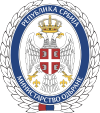Ljubomir Stojanović
Ljubomir Stojanović | |
|---|---|
 | |
| Born | 6 August 1860 |
| Died | 16 June 1930 (aged 69) |
| Nationality | Serbian |
| Occupation(s) | politician, philologist, author, professor |
| Signature | |
Ljubomir Stojanović (Serbian Cyrillic: Љубомир Стојановић, sometimes mentioned as Ljuba Stojanovic) (6 August 1860, Užice – 16 June 1930) was a Serbian politician, philologist and academic.
Biography
[edit]Stojanović was a philologist and historian, who graduated from the School of Philosophy at the Grandes écoles (Serbian: Велика школа, the Grandes Écoles). After studies in Belgrade he went on to post-graduate studies in Vienna, St. Petersburg and Leipzig.[1] At first a grammar school professor, he was appointed university professor at his alma mater, the Grandes écoles (1891-1899). Opposed to the royal absolutism of King Aleksandar I Obrenović, Stojanović joined the People's Radical Party of Nikola Pašić in 1897.[2]
After the split with the older generation of Radicals who accepted the compromise with the Crown in 1901, Stojanović led the younger group of Radicals, forming the Independent Radical Party (Samostalna radikalna stranka).[2] As a founding member and a leader of the Independent Radical Party in Serbia, Stojanović was several times Minister of Education and Religious Affairs (1903, 1904, 1906, 1909), and Prime Minister from May 1905 to March 1906,[3] under the democratic and constitutional rule of King Peter I Karađorđević.[citation needed]
After the First World War Stojanović was one of the founders of the Yugoslav Republican Party and its first president.[2] Stojanović was often described as a puritan moralist in politics.
From 1913 to 1923 he was Secretary of the Serbian Royal Academy, future Serbian Academy of Sciences and Arts.[4] Stojanović was very prolific in various scientific fields, publishing a dozen volumes of medieval Serbian manuscripts and documents including Miroslavljevo Jevandjelje (Miroslav Gospel), and Stari srpski zapisi i natpisi (Old Serbian inscriptions and records) (in six volumes), along with medieval Serbian charters and letters as well as medieval Serbian genealogies and annals. Stojanović published the catalogues of medieval Serbian manuscripts and old books in the National Library of Serbia in Belgrade as well as the catalogue of manuscript collection at the Serbian Royal Academy.
A scholar of enormous erudition, energy and determination, Stojanović published 17 volumes of works of Vuk St. Karadžić, the main reformer of the Serbian alphabet, including several volumes of his extensive correspondence.[5] He also wrote a detailed biography on Karadžić.[2] Stojanović wrote grammar textbooks for Serbian secondary schools, published important scholarly studies of old Serbian printing MA,[citation needed] Serbian churches from 15th to 16th century, the Archbishop Danilo II (Serbian: Архиепископ Данило II).[citation needed]
Selected works
[edit]- Lekcije iz srpskoga jezika za I razred gimnazije, sastavio Ljub. Stojanović, Belgrade, u Državnoj štampariji kraljevine Srbije, 1891.
- Katalog rukopisa i starih štampanih knjiga, zbirka Srpske Kraljevske Akademije, sast. Ljub. Stojanović, Srpska kraljevska akademija, Belgrade, Državna štamparija, 1901.
- Miroslavljevo jevanđelje ( Évangéliaire ancien serbe du prince Miroslav), Preface (in Serbian and French) and notes (pp. 203–229) by Ljubomir Stojanović. - "Édition de sa majesté Alexandre I roi de Serbie" p. [iv], Fotografska reprodukcija i štampa c. i k. dvorskog umetničkog zavoda Angerera i Gešla, Vienna, 1897.
- Katalog Narodne biblioteke u Beogradu, Rukopisi i stare štampane knjige, edited by Ljomir Stojanović, Belgrade, Državna štamparija 1903.
- Republikanski pogledi na nekoliko savremenih pitanja, Ljub. Stojanović, Belgrade, Geca Kon Publishing House, 1920.
- Stari srpski rodoslovi i letopisi, par Ljubomir Stojanović, Sremski Karlovci, Srpska kraljevska akademija, 1927.
- Stari srpski zapisi i natpisi, vol. I- VI, edited and composed byLjubomir Stojanović, Srpska kraljevska akademija, Sremski Karlovci, Srpska manastirska štamparijia, 1926.
- Stare srpske povelje i pisma. Knjiga I, Dubrovnik i susedi njegovi. Drugi deo, edited and composed by Ljubomir Stojanović, Belgrade - Sremski Karlovci, Srpska manastirska štamparijia, 1934.
- Život i rad Vuka Stefanovića Karadžića (26. okt. 1787 - 26. jan. 1864), Belgrade, Geca Kon Publishing House, 1924, XXIV-783 p.
- Srpska gramatika za III razred gimnazije, Belgrade, Geca Kon Publishing House, 1921.
Legacy
[edit]He is included in The 100 most prominent Serbs.
References
[edit]- ^ Aleksandar Mladenović, Aleksandar (1990). "Ecrits consacrés à Ljubomir Stojanović". Užički zbornik. 9: 28.
- ^ a b c d Roszkowski, Wojciech; Kofman, Jan (2016). Biographical Dictionary of Central and Eastern Europe in the Twentieth Century. Routledge. p. 3733. ISBN 9781317475934.
- ^ Markovich, Slobodan G. (2000). British Perceptions of Serbia and the Balkans, 1903-1906. Dialogue. p. 245. ISBN 9782911527012.
- ^ "Ljubomir Stojanović". sanu.ac.rs.
- ^ Wilson, Sir Duncan (1986). The Life and Times of Vuk Stefanović Karadzić, 1787-1864: Literacy, Literature, and National Independence in Serbia. Michigan Slavic Publications. p. 403. ISBN 9780930042639.
Further reading
[edit]- Milan Grol: "The Temptations of democracy", Službeni Glasnik, 2006.
- Dušan T. Bataković, Yougoslavie. Nations, religions, idéologies, Lausanne, L'Age d'Homme; 1994.
- Bataković, Dušan T., ed. (2005). Histoire du peuple serbe. Lausanne: L’Age d’Homme. ISBN 9782825119587.


